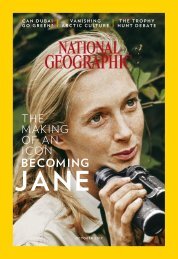NC
Create successful ePaper yourself
Turn your PDF publications into a flip-book with our unique Google optimized e-Paper software.
THE GLOBAL FINA<strong>NC</strong>IAL CRISIS OF 2008 and<br />
2009 brought Dubai’s boom to a halt. Tourism<br />
plummeted; so did real estate prices. Dubai had<br />
to be bailed out of debt by Abu Dhabi. “The economic<br />
crisis was probably the best thing that happened<br />
to us—a blessing in disguise,” says Habiba<br />
Al Marashi, co-founder of the Emirates Environmental<br />
Group, a recycling and education outfit.<br />
“It slowed down the crazy pace of construction.”<br />
As the city drew breath, it had several reasons<br />
to reconsider its path. At Dubai Holding, Sheikh<br />
Mohammed’s own development company, “one<br />
of the issues was how Dubai was going to source<br />
they’re still subsidized), and new buildings are<br />
no longer built as if energy and water were limitless,<br />
says Saeed Al Abbar, who heads the Emirates<br />
Green Building Council. They may still have glass<br />
facades, but they must have solar water heaters,<br />
for example, and systems that automatically lower<br />
lights and air-conditioning when people are<br />
absent. “What I’ve seen is a huge change,” Al Abbar<br />
says. He’s helping design one of Dubai’s first<br />
“net zero energy” office buildings, which will produce<br />
as much energy as it consumes.<br />
The first net-zero-energy housing development<br />
has opened south of town. The secret of the<br />
‘The economic crisis was a blessing in disguise.’<br />
Habiba Al Marashi, environmental activist<br />
the energy to power all these enormous real estate<br />
developments,” says energy consultant Robin<br />
Mills, who worked there at the time. Green alternatives<br />
were in the air: Masdar City, designed<br />
by the firm of star architect Norman Foster and<br />
billed as the world’s first zero-carbon city, car<br />
free and solar powered, was just beginning to rise<br />
from the sands of Abu Dhabi.<br />
Most important, the price of solar power was<br />
plummeting—and it has continued to do so such<br />
that now, Mills says, “solar is clearly by far the<br />
cheapest form of electricity” in Dubai. This past<br />
February, when I visited the Mohammed bin<br />
Rashid Al Maktoum Solar Park, 30 miles south of<br />
downtown, DEWA was just completing the installation<br />
of 200 megawatts’ worth of solar panels, and it<br />
had signed a contract for the next 800 megawatts—<br />
at 2.99 cents a kilowatt-hour. It’s planning for<br />
5,000 megawatts at the site by 2030. And unlike<br />
many American utilities, it’s also encouraging residents<br />
to put solar panels on their roofs.<br />
“The solar potential is so great here,” Mills<br />
says. “Millions of acres of empty desert and plenty<br />
of roof space. Electricity generation—for me<br />
it’s almost ‘problem solved.’ ”<br />
After the profligate boom years, Dubai also is<br />
trying to restrain demand for electricity and water.<br />
Prices have increased substantially (though<br />
Sustainable City, says its developer, Faris Saeed,<br />
a reformed builder of glass towers, is not just the<br />
solar panels that shade every parking space and<br />
roof terrace, nor the solar water heater that supplies<br />
each house. It lies in simple choices—such<br />
as packing the 500 L-shaped houses close enough<br />
together on narrow streets to shade one another,<br />
as the old houses near the Creek do. That allowed<br />
the air-conditioning units to be much smaller<br />
and cheaper, Saeed says. Extra insulation and<br />
reflective windows and paint cut energy use<br />
even further. “It’s a myth that sustainable has to<br />
be more expensive,” he says.<br />
All these efforts have begun to pay off. Per<br />
capita consumption of water and electricity is<br />
falling, and, the government says, so are per capita<br />
carbon emissions, the main driver of Dubai’s<br />
enormous footprint. The average Dubai resident<br />
now “emits” less than 18 metric tons a year, just<br />
a shade more than the average American. But total<br />
consumption and emissions are still growing<br />
because the population is. And a Dubai resident<br />
still emits three times as much as a resident of<br />
New York City—in part because Dubai grew,<br />
like many American cities, into a car- centered<br />
sprawl. Residents of Saeed’s pedestrian- friendly<br />
development can walk to restaurants, a grocery<br />
store, and a mosque, and a school is on the<br />
DUBAI’S AUDACIOUS GOAL 63



